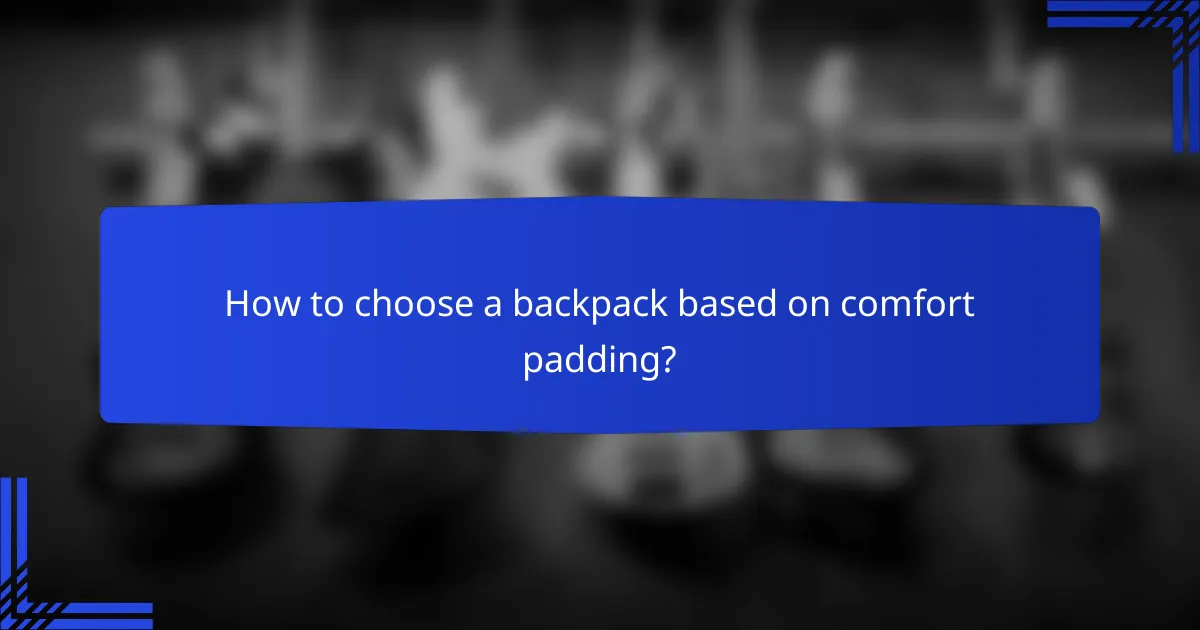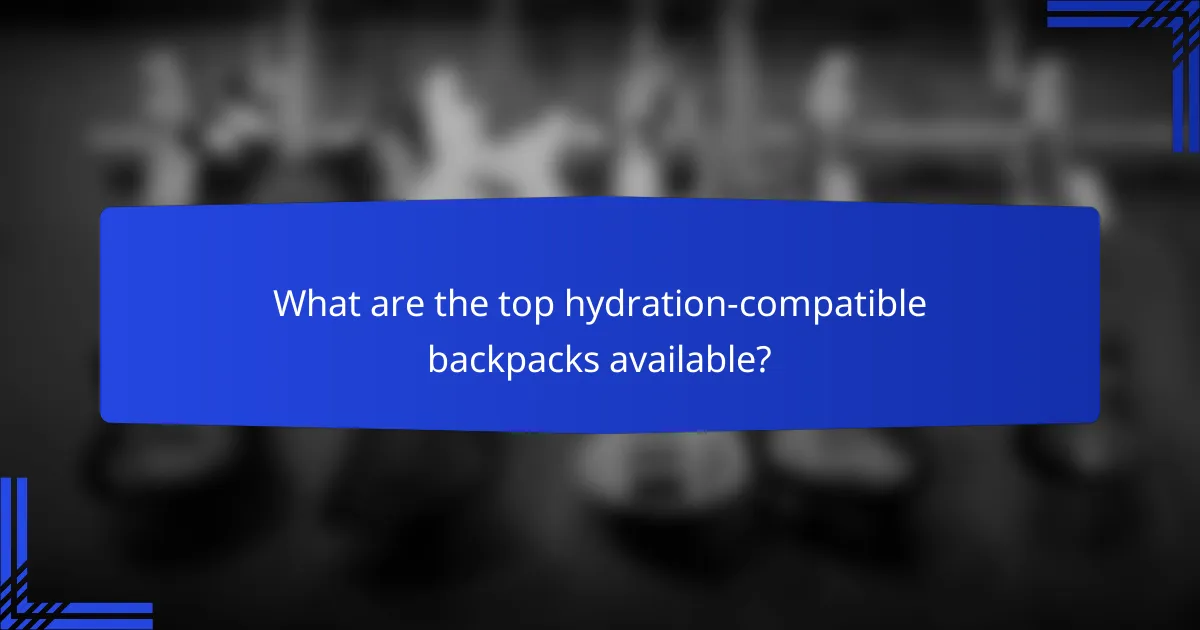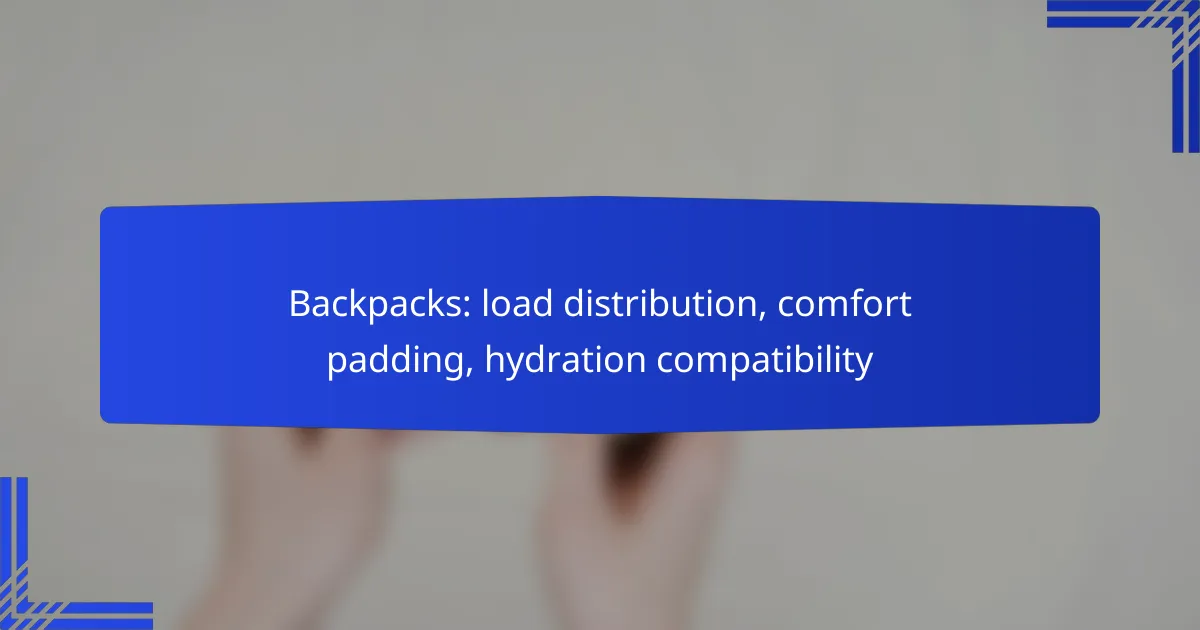Backpacks are designed to effectively distribute load, enhancing comfort and stability for the user. With features like comfort padding and hydration compatibility, they minimize strain and allow for easy access to water, making them ideal for extended wear and outdoor activities.

How do backpacks distribute load effectively?
Backpacks distribute load effectively by utilizing various design features that balance weight across the body, enhancing comfort and stability. Proper load distribution minimizes strain and fatigue, allowing for longer and more enjoyable carrying experiences.
Weight distribution systems
Weight distribution systems in backpacks are designed to spread the load evenly across the shoulders, back, and hips. Common systems include adjustable straps, hip belts, and load compression straps. These features help to shift some of the weight from the shoulders to the hips, which can significantly reduce fatigue during long hikes.
When selecting a backpack, look for models that offer customizable weight distribution options. This allows you to tailor the fit according to your body shape and the load you are carrying, ensuring maximum comfort.
Frame types and their impact
The frame of a backpack plays a crucial role in load distribution. There are generally two types of frames: internal and external. Internal frames are designed to fit closely to the body, providing better stability and maneuverability, while external frames can carry heavier loads but may be less stable on uneven terrain.
Choosing the right frame type depends on your intended use. For day hikes or light backpacking, an internal frame is often preferable. For extended trips with heavier gear, an external frame might be more suitable due to its additional support and capacity.
Load lifters and their function
Load lifters are straps located near the top of the backpack that connect the top of the frame to the shoulder straps. They are designed to pull the load closer to your body, improving balance and reducing strain on the back. Properly adjusted load lifters can help you maintain an upright posture while carrying a heavy load.
To effectively use load lifters, adjust them so that they create a slight upward angle, ideally between 30 to 45 degrees. This positioning helps to stabilize the load and distribute weight more evenly, enhancing overall comfort during your hike.

What features enhance comfort padding in backpacks?
Comfort padding in backpacks is enhanced by the use of various materials, adjustable straps, and thoughtful back panel designs. These features work together to distribute weight evenly, reduce pressure points, and improve overall user experience during extended wear.
Types of padding materials
Backpacks typically use foam, gel, or air-filled padding to provide comfort. Foam padding is common for its lightweight and supportive qualities, while gel padding offers superior shock absorption. Air-filled padding can be adjusted for firmness, allowing for a customized fit.
When selecting a backpack, consider the type of padding that best suits your needs. For hiking or long-distance travel, thicker, more durable padding may be beneficial, while lighter padding may suffice for casual use.
Adjustable straps for better fit
Adjustable straps are crucial for achieving a comfortable fit, as they allow users to customize the backpack’s position on their body. Look for backpacks with both shoulder and sternum straps that can be easily modified to accommodate different body shapes and sizes.
Ensure that the straps distribute weight evenly across the shoulders and chest. Straps that are too loose can lead to shifting and discomfort, while overly tight straps can cause chafing and restrict movement.
Back panel designs for airflow
Back panel designs that promote airflow help to reduce sweat and increase comfort during use. Many backpacks feature mesh panels or channels that allow air to circulate between the pack and the wearer’s back.
When choosing a backpack, consider models with ventilated back panels, especially for warm-weather activities. This feature can significantly enhance comfort by keeping you cooler and drier on the go.

How does hydration compatibility work in backpacks?
Hydration compatibility in backpacks refers to the design features that allow users to carry and access water easily while on the move. This typically includes systems for holding hydration reservoirs or bladders and routing drinking tubes for convenient sipping without stopping.
Hydration reservoir systems
Hydration reservoir systems are built into backpacks to hold water in a flexible bladder, which can range from a few liters to over ten liters in capacity. These systems often include a dedicated compartment to prevent leaks and ensure easy access. When choosing a backpack, consider the size of the reservoir and how it fits your hydration needs during activities like hiking or biking.
Additionally, look for features such as insulation to keep water cool and a wide opening for easy filling and cleaning. Some backpacks also have built-in clips or sleeves to secure the reservoir in place, which can enhance stability while you move.
Compatible hydration bladders
Compatible hydration bladders are designed to fit specific backpacks and typically feature a standard opening and tube connection. Most bladders are made from durable, BPA-free materials and can hold anywhere from 1 to 3 liters of water. When selecting a bladder, ensure it is compatible with your backpack’s hydration system to avoid leaks and ensure a snug fit.
Some brands offer bladders with additional features, such as antimicrobial coatings to prevent mold growth or quick-release valves for easy removal. Always check the manufacturer’s specifications for compatibility to maximize performance.
Tube routing options
Tube routing options refer to how the drinking tube is positioned for easy access while wearing the backpack. Many backpacks have designated ports or channels that allow the tube to run from the reservoir to the shoulder strap, keeping it secure and out of the way. Choose a backpack that offers adjustable routing options to suit your comfort and usage style.
Consider whether the tube can be routed on either side of the backpack, which can be beneficial for left- or right-handed users. Additionally, look for features like magnetic tube holders or elastic bands to keep the tube in place during movement, reducing the risk of snagging or tangling.

What are the best backpacks for load distribution in New Zealand?
The best backpacks for load distribution in New Zealand are designed to evenly distribute weight across the body, enhancing comfort during long hikes. Look for features like adjustable suspension systems, padded hip belts, and load-lifting straps to ensure a balanced carry.
Osprey Atmos AG
The Osprey Atmos AG is renowned for its Anti-Gravity suspension system, which provides excellent load distribution and ventilation. This design allows the pack to conform to your body while minimizing pressure points, making it ideal for multi-day treks across New Zealand’s diverse landscapes.
Consider the adjustable harness and hip belt, which can be tailored to fit various body shapes. This customization enhances comfort and stability, especially when carrying heavier loads. The Atmos AG also features ample storage options, including multiple pockets and attachment points for gear.
Deuter Aircontact Lite
The Deuter Aircontact Lite is a versatile backpack that excels in load distribution thanks to its ergonomic design and durable materials. It features a comfortable back system that helps to stabilize the load, making it suitable for both short and extended trips in New Zealand’s rugged terrain.
This backpack includes a removable lid that can be converted into a daypack, providing flexibility for shorter excursions. Additionally, its reinforced hip belt ensures that the weight is transferred effectively to your hips, reducing strain on your shoulders during long hikes.
Gregory Baltoro
The Gregory Baltoro is designed for heavy loads, making it a top choice for serious backpackers in New Zealand. Its adjustable torso length and customizable fit allow for optimal load distribution, ensuring comfort even on challenging trails.
This pack features a well-padded hip belt and a dynamic suspension system that moves with you, enhancing stability. With multiple compartments and pockets, the Baltoro offers excellent organization for gear, making it easier to access essentials while on the move.

How to choose a backpack based on comfort padding?
Choosing a backpack with the right comfort padding is essential for ensuring a pleasant carrying experience. Look for padding that balances thickness and support while fitting your body shape and intended use.
Evaluating padding thickness
Padding thickness plays a crucial role in comfort. Thicker padding generally provides more cushioning, which can be beneficial for heavier loads or long durations. However, overly thick padding may add unnecessary weight and bulk, so aim for a thickness that offers support without compromising mobility.
For daily use, a padding thickness of around 1-2 inches is often sufficient, while hiking or travel backpacks may benefit from thicker padding, around 2-3 inches, especially in areas like the back and shoulder straps.
Testing fit and comfort
To ensure a backpack fits well and feels comfortable, try it on with weight inside. Walk around for a few minutes to assess how the padding interacts with your body. Pay attention to pressure points, particularly on your shoulders and lower back.
When testing, adjust the straps to find the best fit. A well-fitted backpack should sit snugly against your back without shifting excessively. If possible, check for adjustable features that allow you to customize the fit for your body type.

What are the top hydration-compatible backpacks available?
Hydration-compatible backpacks are designed to integrate hydration systems, allowing users to stay hydrated during outdoor activities. Some of the top options include the CamelBak M.U.L.E. and the Hydrapak Seeker, both offering unique features tailored for comfort and convenience.
CamelBak M.U.L.E.
The CamelBak M.U.L.E. is a popular choice among cyclists and hikers for its balance of storage and hydration capacity. It typically includes a 3-liter reservoir and features a well-ventilated back panel for comfort during extended use.
This backpack is equipped with multiple compartments, making it easy to organize gear while keeping the hydration system accessible. Consider its lightweight design and adjustable straps, which enhance load distribution and overall comfort.
Hydrapak Seeker
The Hydrapak Seeker is a versatile hydration backpack that stands out for its collapsible design, making it easy to pack and carry. It usually features a 2-liter reservoir and is made from durable, lightweight materials suitable for a variety of outdoor adventures.
One of the key advantages of the Seeker is its compatibility with various hydration systems, allowing users to customize their setup. Its minimalist design and adjustable straps ensure a comfortable fit, making it ideal for day hikes or travel.

What are the key criteria for selecting a backpack?
When selecting a backpack, key criteria include load distribution, comfort padding, and hydration compatibility. These factors significantly impact how comfortable and functional the backpack will be during use.
Load Distribution
Load distribution refers to how weight is spread across the body when carrying a backpack. A well-designed backpack should distribute weight evenly between the shoulders, back, and hips to minimize strain and fatigue. Look for features like padded hip belts and adjustable shoulder straps to enhance load distribution.
Consider the type of activities you’ll be doing. For hiking or long treks, a backpack with a higher capacity and a frame that supports weight transfer to the hips is ideal. For day trips, a smaller pack with a simple design may suffice.
Comfort Padding
Comfort padding is essential for ensuring a pleasant carrying experience, especially during extended use. Look for backpacks with padded shoulder straps, back panels, and hip belts to provide cushioning and reduce pressure points. The material should also be breathable to prevent overheating.
When trying on a backpack, pay attention to how the padding feels against your body. A good fit will feel snug without being restrictive, allowing for movement without discomfort.
Hydration Compatibility
Hydration compatibility is a crucial feature for outdoor activities, allowing easy access to water while on the go. Many backpacks come with built-in hydration reservoirs or compartments for water bottles. Ensure the backpack has a dedicated sleeve for a hydration bladder and a tube exit for convenience.
For hiking or biking, consider packs that include insulated compartments to keep your water cool. Additionally, check for external pockets that can securely hold water bottles for quick access during your adventures.
